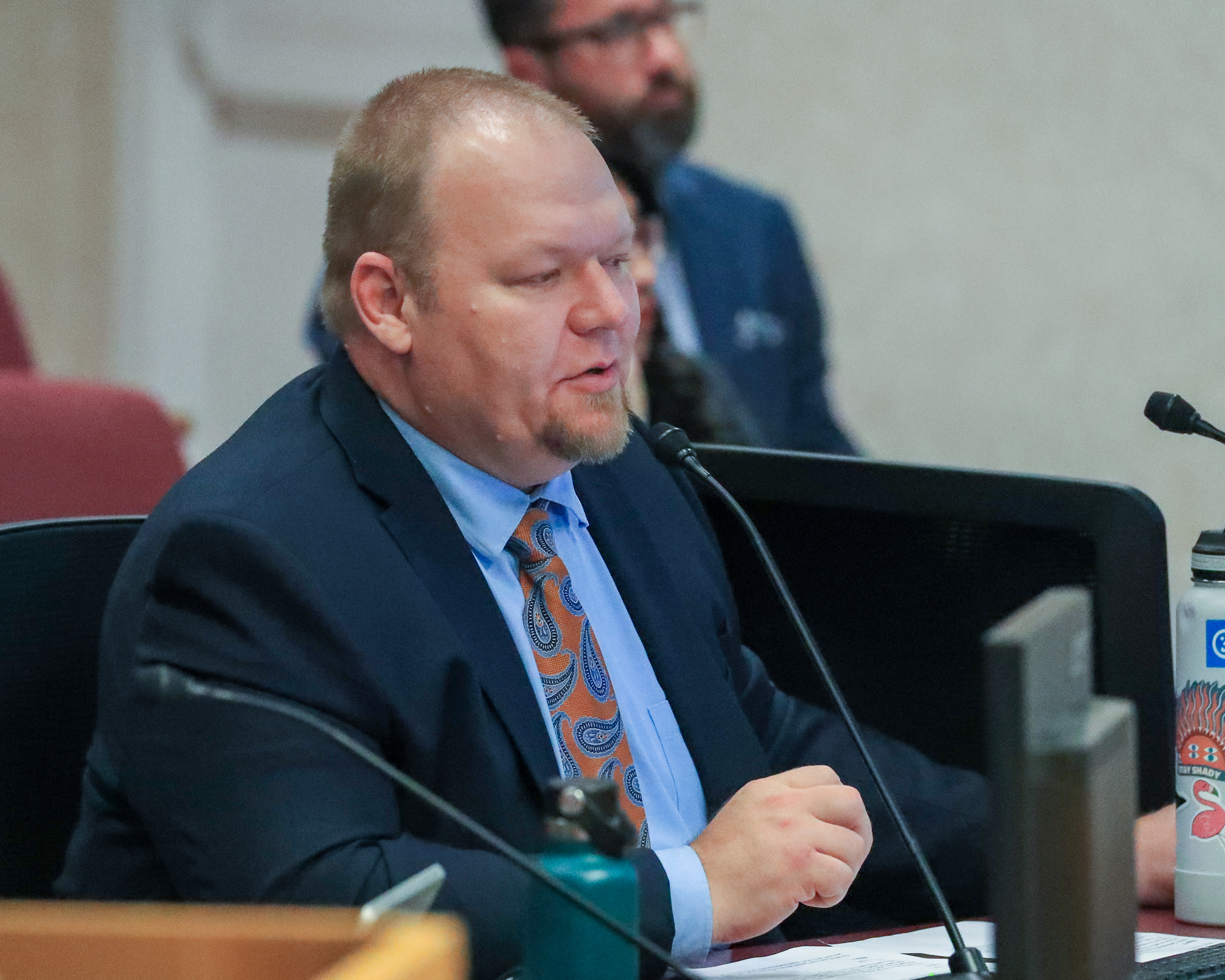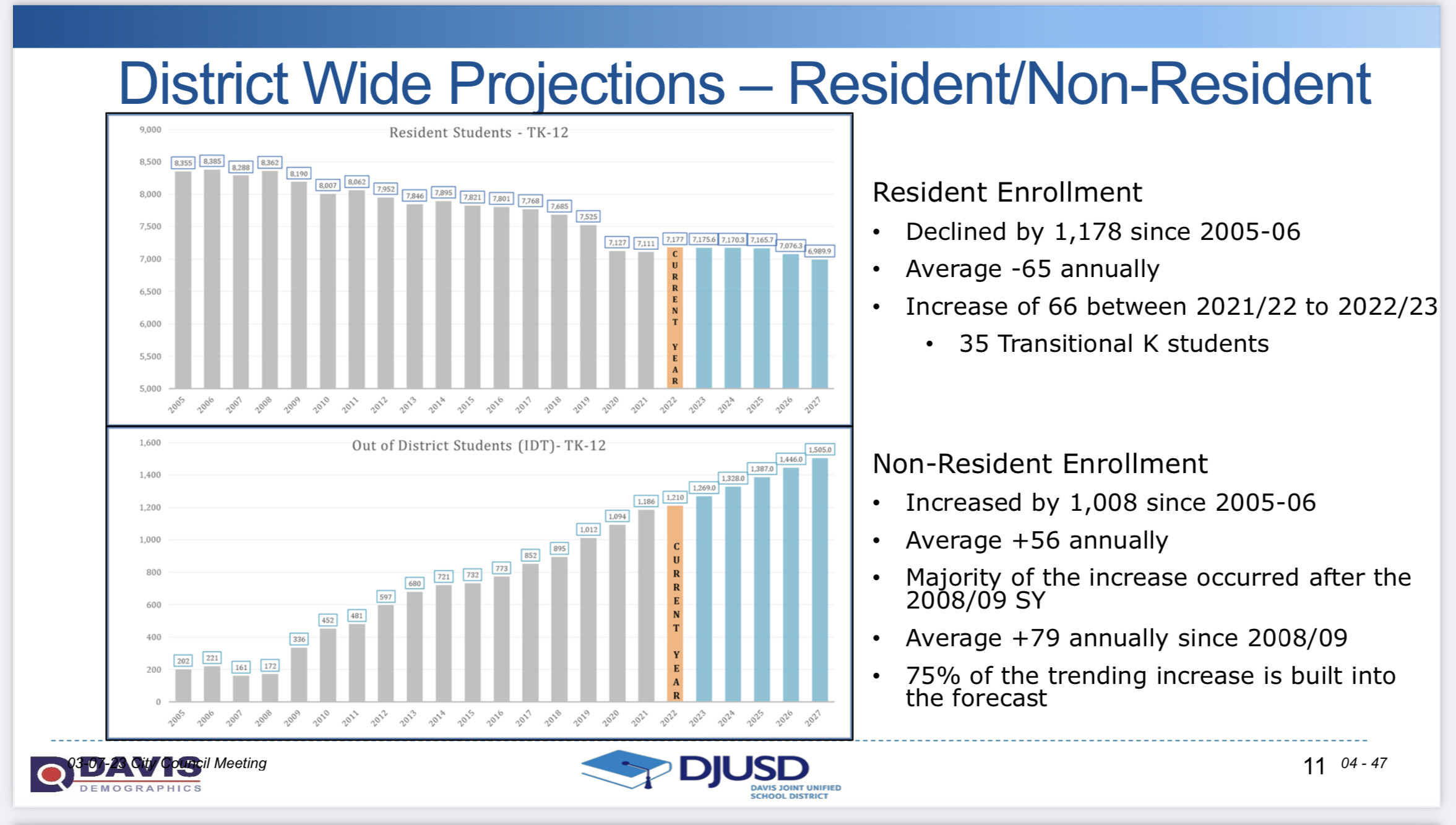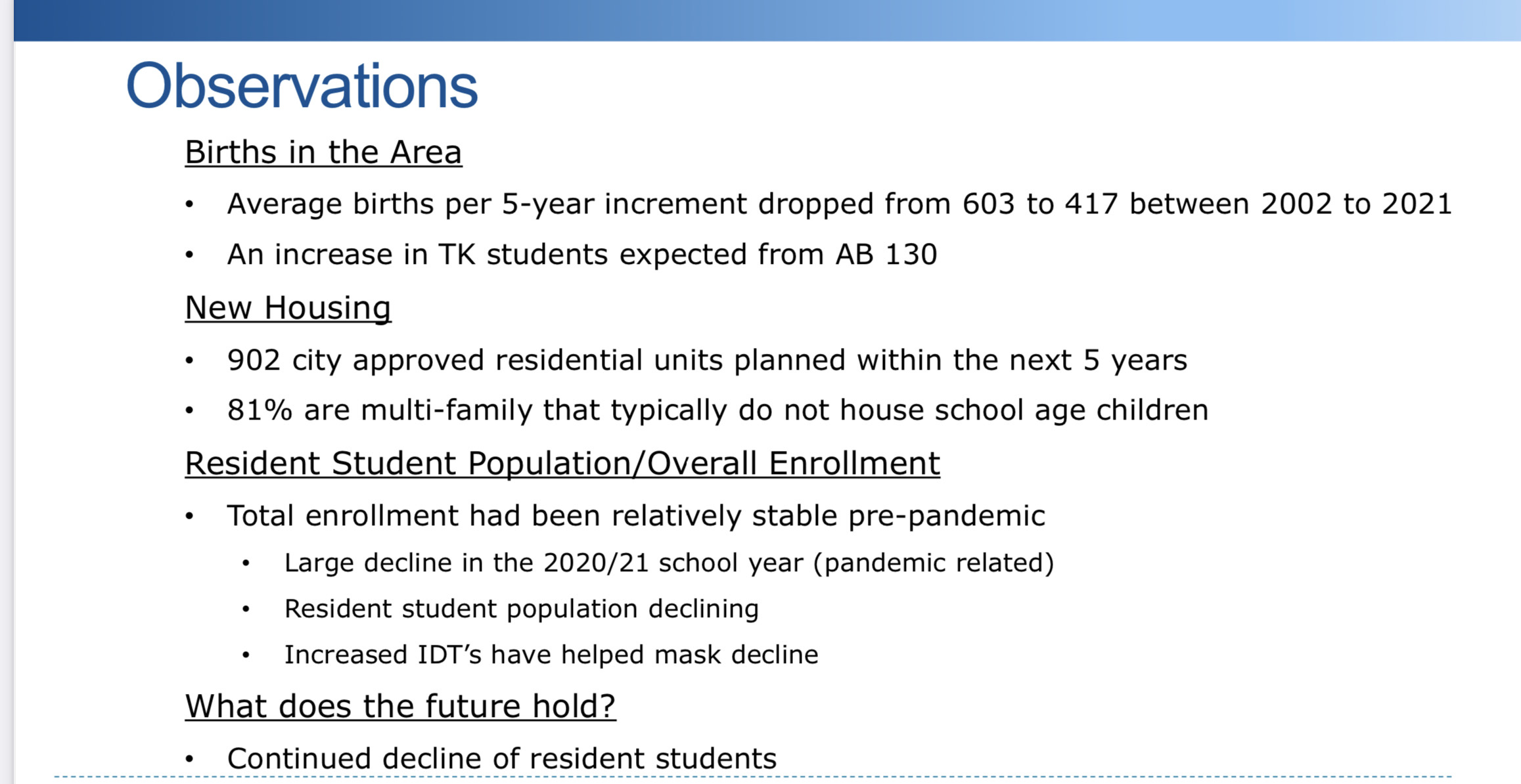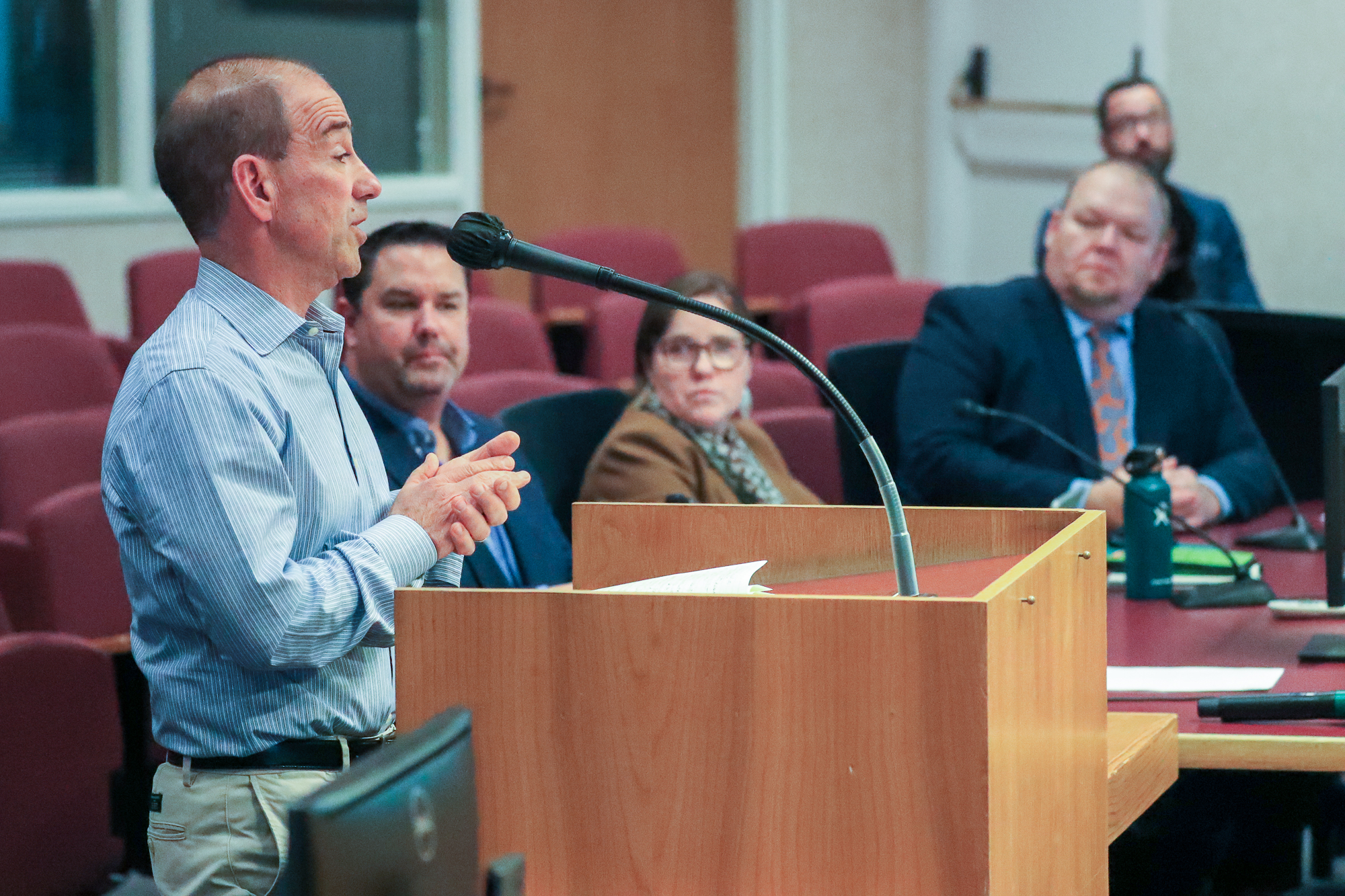

By David M. Greenwald
Executive Editor
Davis, CA – DJUSD Superintendent Matt Best delivered a message that many have been warning about for the past decade—the cost of housing in Davis has led to a decline in resident enrollment which, while bolstered by non-resident transfers, presents warning signs.
The bottom line, Best said, “We know that our resident student numbers are declining and that’s masked by increasing non-resident students.”
As board member Joe DiNunzio put it, “We’re nearing a tipping point.” He said, “I think we are coming very close to the ceiling on the number of non-resident students we have. And if those numbers do in fact fall, then it’s going to have a huge impact on our  ability to maintain the school system that we currently have.”
ability to maintain the school system that we currently have.”
For their part, the council heard the message loud and clear. How much they can do at this point remains to be seen.
During the Superintendent’s presentation, he presented the mobility chart and whether families are moving in or out of the district—and where.

As he explained, “Green means that there are more students entering the district between that grade in that area, and the red means folks are leaving.”
As he noted, “20 years ago, this chart had a lot more green on it, which meant that more students were entering our district from grade level to grade level, in these catchment areas, whereas in, in this particular year, you’re seeing more red.”
He added, “We were sort of trending down pre-pandemic, and you can definitely see the post-pandemic effects there.”

Superintendent Best noted that because of AB 130, there will now be 14 years rather than just K-12.
As he pointed out, “By 2027, all students who are four years old will be eligible for transitional kindergarten. So we’ve essentially got fewer students spread across more grades, which for any economists in the room, means lower efficiency.”

He explained that the pandemic drop has been “essentially masked by the addition of transitional kindergarten.”
But he warned that “we’re still a hundred students fewer than we were just a few years ago.”
The overall decline is also masked “to a large extent by the increasing number of non-resident students joining our district. It wasn’t until the pandemic that the number of non-residents students stopped keeping up with the number of the decline of resident students.”

Superintendent Best noted that, in addition to the resident population, the non-resident student population which currently is keeping programs open and vibrant has “fewer students in the region, that means that at some point, that non-resident student population is going to either plateau, level off, decrease in its percentage year over year.”
He said that “we are intensely concerned about when that’s going to happen at some point in the future.”
Joe DiNunzio explained that “enrollment is so important because our budget is tied to ADA—the number of average daily attendance of our students.”
As he explained, when the enrollment is declining, “it’s a real challenge” as money declines. He explained that “we are operating right now with a relatively thin margin of budget. So it becomes an extraordinarily big economic challenge.”
DiNunzio emphasized “we collectively have a shared interest.” He said, “I believe from a value standpoint, the school district and the city are tightly aligned.” He said, “We recognize that development and a lot of the political and economic challenges of it are part of the fabric of our community.”

Hiram Jackson, who is a new member of the school board, noted that the demographer was asked “did lower cost housing tend to bring more school going families than more expensive housing? And of course, his answer was yes, that was his experience.”
Jackson said, “I’m concerned that we’re bringing about an economic segregation in Davis. Basically, we’re pricing out lower income people or middle income people even.”
Jackson defended the current out-of-district transfer policy.
He pointed out, “I think we attract some staff and teachers in our district because when they can work here and enroll their kids in the district, then it’s attractive to work in the district.”
Vice Mayor Josh Chapman, responding to the report, noted that he and Mayor Arnold were on the two-by-two when this was originally presented.
He said, “I think my first reaction when I saw a very similar presentation in ours, I think yours as well, was we got to have the school district come and present this to the city council, and then in effect, put this out more publicly into our community to ring the bell around housing in, in our community.”
Mayor Arnold pointed out, “irrespective of student enrollment, we’ve known that for a long time, fewer and fewer teachers are able to live in town. And that’s a big, big loss for our community. And so reversing that on its own, our time will not have been wasted, if we can address that.”
Mayor Arnold also pointed to impacts that maybe we didn’t anticipate at the time.
For instance, he noted that in 2005, “we voted down Covell Village.” But he argued, “we built Covell Village. We just built it five miles up the road and call it North, North Davis—jokingly in Woodland.”
He said that in that campaign, the boogeyman was traffic on Pole Line and Covell.
“Well guess what? Now there’s a lot of traffic on Pole Line and Covell, because zero percent of the people that live in North North Davis are riding their bikes to school or to work or to the grocery store, or any other destination in Davis.”
He said, “So there are consequences to the development decisions we make over the years that are, that are, even the arguments against some of these things come back in our face sometimes.”
There was a joint sense that DJUSD was “a core community asset.”
Will Arnold explained, “As goes the school district—so goes our home values.”
He also answered some commenters on the Vanguard, noting that some on the Vanguard have suggested that “maybe the school district just needs to right size.”
He said, “My response to that would be, well, I hope folks are ready to right size their home values too.”
He said that “the reason that that homes go for one and a half to two times per square foot in Davis as any other neighboring community is not because we have beachfront property, it’s because of the schools.”
The mayor added “this is in my mind, the beginning of a, of a beautiful friendship that we can work together and really hammer this home to our community, how absolutely critical and central it is that we provide the space, for folks who want to live here and teach here, folks who want to live here and, and go to school here.
City Manager Mike Webb added that the district and city “have the tools and the resources and the knowledge, I think to back into some of those numbers that you were talking about and have a real data driven approach to identify what are the numerical needs in terms of housing units based on the type of housing that we see that the school district sees enrollment from historically in town.”
Where that leads the community will depend on a lot of factors that the city will have to come back to in the near future.


This is factually untrue, and Will Arnold should know that.
Planning for Spring Lake preceded the vote for Covell Village by several years.
Had Covell Village been approved, it would not have prevented Spring Lake.
It is disgraceful that school district and city council members are advocating for development to meet the desires of a school district. Though I’m not particularly-surprised regarding some council members, Will Arnold has become a major disappointment.
There is a reason why Spring Lake is called North North Davis.
It’s more than the “desires of a school district.” It’s the desire of the Davis community to have a robust school district that can offer students a variety of sports, music, AP courses, language classes, electives, and choice programs. If you follow the school board, you’ll know that trying to cut these offerings because of low enrollment results in outrage, anger, and disappointment for those families that are still in the district. The question we are asking is how we can attract and retain families in Davis. People seem to be immediately drawn to development as a potential solution. But, what are the other ways that the City can attract families? Young families choose Davis because of the parks, the City recreation program, summer camps, and perceived safety of the town. Young families also need good childcare options, especially infant care. I’d like to see the city invest in these areas while everyone argues about development.
I’d point out a couple of things, regarding this.
First, there’s no evidence that a reduction in enrollment reduces the number of programs. If anything, a reduction in enrollment would enable the existing parcel tax to “go farther”, since it would be reserved for fewer students.
The parcel tax is not dependent upon number of students. However, the more students it serves, the more it’s “stretched”.
As it is, the district is funding non-resident students whose families don’t pay that parcel tax.
Can’t help but remember that there are parents who home school their kids, who “somehow” are able to teach ALL subjects using one “teacher”. This was also the model used in the one-room schoolhouse days.
I’m not advocating either one, just noting that there has been no discussion at all regarding ways in which to preserve programs, in a declining-enrollment environment. While also noting that the amount of parcel tax which funds them is not impacted in any way, by declining enrollment.
I believe that the motivation here is to preserve the “system” for the benefit of those employed by it, and a small minority of families who will ultimately be forced to attend a different school. Is that any way to make decisions which impact an entire city?
People with kids in the school system (at any given time) are a decided minority in the first place, regarding the population at large. As such, they should not be driving planning/development policy for the entire city. And yet, that’s been the “norm” for way too long.
Maybe. Or, maybe we can just accept that people are having fewer kids, these days. Millennials aren’t even having kids at a rate to replace themselves.
The chief reason why families don’t move into Davis and families are moving out is the exceedingly high cost of housing. Only when housing supply meets the demand will housing costs level out and begin to decrease. The areas that Cindy articulates are all secondary. It’s my understanding that the city is still in a budget deficit. The increased funding that Cindy advocates for would either have to be taken away from other programs or found by increasing taxes.
The “chief” reason is that existing residents/families are aging out of the school system. This is also occurring in Woodland, in the older parts of town. In fact, it’s occurring throughout most of California.
And those who move in have fewer school-age kids, themselves. Even in existing single-family housing (or new single-family housing, such as that found in The Cannery).
And there’s no reason to believe it would ultimately be any different for any other “new” housing development. (As if that’s a “legitimate” reason to pursue this type of Ponzi scheme in the first place.)
Now, I suppose that a place like Davis *might* be able to continue sprawling outward forever, in an attempt to overcome (or delay the impact of) changing demographics. (In fact, that’s exactly what’s being advocated, here.)
It would be laughable, if some others on here (and on the council) weren’t actually advocating for this with a straight face. Especially for anyone who simultaneously claims any environmental or city concerns whatsoever.)
So are you advocating for the Woodland School District to downsize?
Yes – I have done so, regarding the schools on the West side of town – where enrollment is declining and the buildings need work, I believe.
As you can imagine, they are also resistant to that suggestion. In fact, I believe they’re pouring more money into those facilities.
Ron O
If you think that DJUSD is so misdirected, you should run for school board. All of the offices were uncontested last year. Oh, but’s that’s right–you don’t live in Davis, you live in Woodland! You opinions about how Davis runs its rather successful district are irrelevant to the discussion.
The fact is that Spring Lake would not have been has extensive if Covell Village had been built. Spring Lake has been expanded in several phases since 2005. Traffic down Pole Line would have been much less and the environmental impact significantly less with Covell Village. We missed an important opportunity.
What are these “desires” of the district? To maintain sufficient teaching staff to provide the education services desired by parents? To maintain the revenues required to pay for existing facilities and associated construction debt so as to reduce tax payments as desired by tax payers?
This is also factually untrue.
The ultimate size of Spring Lake was established well-before the Covell Village vote.
And yet, you continue to respond to me.
To avoid (at any/all cost) a need to “right-size” the district to match the needs of the existing city. And that “cost” includes a total disregard for the impacts of more sprawl.
Not to mention subsidizing the cost out-of-district students, or the impact that might have on other districts.
Most of those students come from families who have jobs in Davis. That they don’t pay the parcel tax is the structural pay bonus required to be able to hire those workers, mainly because they can’t afford to live in Davis.
There is also no correlation between who pays the parcel taxes and who attends the schools. It’s just a tax on property. Business owners pay it, senior citizens pay it (if they don’t choose to opt out), people with no kids pay it. Unless Davis becomes a charter city and levies taxes on income or other sources, the parcel tax is the only mechanism available.
If you want to build housing that will attract families with kids, you need to build single-family homes with yards. Infill won’t achieve that. Downtown redevelopment won’t achieve that. The city will need to put development proposals on the ballot that annex land and allow for sufficient housing with adequate incentive for builders to provide a range of lot sizes and prices.
Davis needs a normal subdivision of the kinds of houses that people want to actually live in.
I (sort of) agree with you, Don (regarding the type of housing that appeals to families). Square footage, yards, 2-3 car garage spaces, etc.
The thing is that Spring Lake already provides that, at a cheaper price than what would be available in Davis.
That’s not an “advocacy” for Spring Lake – it’s just a reality. Other nearby communities do, as well (but Spring Lake is the closest).
There’s also going to be another 1,600 housing units at the technology park site, when that’s finally built. (I’m referring to the proposal which failed in Davis before even reaching voters, and added 1,600 housing units during its “move” 7 miles north of its original proposed location.
Then again, there’s The Cannery – which contains that same type of housing (but did not result in a desired “head count” of students).
Go figure.
But I’ve yet to “figure” why this is a goal in the first place.
Nor do I see a reason that there’s an assumption that existing housing stock doesn’t eventually turn-over. Perhaps not “fast enough” for a school district that’s desperately trying to avoid right-sizing, but nevertheless turnover does ultimately occur.
Davis already has LOTS of single-family housing. No one has explained how there’s a supposed “shortage” of it, or the reason it’s expected to “produce” a sufficient, continuing number of children to satisfy an ever-hungry school district.
Which again returns me to my main point: School districts serve communities, not the other-way around.
Most of my friends who have kids both in the United States and especially in Europe actually live in apartment buildings in complete neighborhoods and the kids are doing well… better than the average suburban kids in the US.
I’m not denying that lots of people think they need yards for their dogs and their kids and think that they need to make the time to take care of the yards and drive the kids everywhere and get the tired kids to pick up the crap that the dogs leave in the backyard when they’re there all day.
But the planet can’t handle it.
“Most of my friends who have kids both in the United States and especially in Europe actually live in apartment buildings in complete neighborhoods ”
That might be true, but it’s not what the data says across the country. And it’s not even close.
With that said, finding ways to make single family housing environmentally friendly and affordable is difficult.
I do want to note that you are one of the few people who speaks out on these issues who actually lives in multi-family housing, and you seem to prefer to do so. I see no contradiction between the way that you live and what you advocate for and want to acknowledge that.
Nearly all of the others commenting on these topics in public live in single-family homes with yards. They have things like gardens and fruit trees and pets, and they enjoy the privacy. I have to question whether they would prefer to live in the sorts of high-density downtown neighborhoods for which they are advocating. Or, as I said before, apparently they would vote against allowing the kinds of housing they themselves prefer.
The overwhelming majority of people (I’m talking 90%+) who get together a down payment and qualify for a home loan want a single-family home with a yard. That is a provable fact. So, refusing to allow it to get built here simply moves those people up the road or down the freeway.
The way to make some of those homes more affordable is to make some of them smaller with smaller yards. Duplexes and quad-plexes have a long history in Davis and integrate very readily into s-f neighborhoods.
Every home now has to have solar power (a very unfortunate policy from the standpoint of a healthy urban forest, but we’ll just have to work with it). Vehicles are increasingly based on renewables. Renewable energy sources are being adopted much more quickly than was assumed 10 – 20 years ago. Public transit within Davis seems efficient and reliable and can readily be expanded to include a new peripheral subdivision.
Our approach to housing and climate issues needs to be pragmatic.
Don Shor said … “ Davis needs a normal subdivision of the kinds of houses that people want to actually live in.”
The challenge that that approach faces is that the developers/builders want to build houses that cost an average price of $899,000 or more. That doesn’t help our housing affordability problem at all.
They won’t all be that price. Blocking projects because of demands about affordability has become a standard method now for obstructing housing projects. The city can control densities in order to achieve greater affordability. Yes, there will be high-cost homes in any new subdivision.
Don, I agree they won’t all be that expensive, but on average they will be if the developers/builders get their way. The $899,000 is the average price of a single family detached home in Davis in 2022. The City can try to control the developer/builder pricing decisions, but that is all they can do … try.
On a related housing affordability subject, the lead article in the Davis Enterprise … County officials see signs of ‘eviction tsunami’ … does not bode well for apartment affordability. As the article points out
.
The likely new tenants in the eviction apartments are UCD students with the financial wherewithal to pay the rent levels that the evicted low-income families and senior tenants can not afford.
New single-family houses would be more than that.
New single-family houses in Spring Lake are considerably-less (but are still generally around $650 K and more). That’s why Spring would continue to attract families who don’t want to pay $1 million for what is essentially a traditional, single-family house, but still desire proximity to UCD or Sacramento, for example.
I’m also failing to see the reason that Davis wants to specifically attract “poor” families. Don’t “rich” families have kids, too? (Well, maybe not – if you look at The Cannery). I’ll refrain from any comments regarding the result of having kids – in regard to wealth.
For that matter, wouldn’t “wealthy” families (or individuals) have a more-positive fiscal impact on the city, than “poor” families (or individuals)? Starting with the amount of property tax collected (based upon value of a house)?
I’ve yet to see a coherent explanation why the pursuit of additional families (beyond those already living in the enormous existing supply of single-family housing) is a “goal”. (Regardless of wealth.)
Where is that “goal” arising from, other than from a school district which doesn’t want to “right-size”?
The City should team up with DJUSD to build Affordable housing on DJUSD land for teachers with rents low enough for teachers to save towards a down payment. Recent law changes would help facilitate such a project on district land. Also the city is now taking donations into its affordable housing fund along with payments from developers. I don’t know if prevailing wage laws would kill such a project financially or if there is a work around but I think its worth looking into.